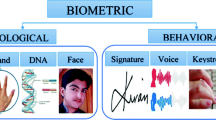Abstract
Signature verification is a common task in forensic document analysis. It is one of determining whether a questioned signature matches known signature samples. From the viewpoint of automating the task it can be viewed as one that involves machine learning from a population of signatures. There are two types of learning to be accomplished. In the first, the training set consists of genuines and forgeries from a general population. In the second there are genuine signatures in a given case. The two learning tasks are called person-independent (or general) learning and person-dependent (or special) learning. General learning is from a population of genuine and forged signatures of several individuals, where the differences between genuines and forgeries across all individuals are learnt. The general learning model allows a questioned signature to be compared to a single genuine signature. In special learning, a person’s signature is learnt from multiple samples of only that person’s signature– where within-person similarities are learnt. When a sufficient number of samples are available, special learning performs better than general learning (5% higher accuracy). With special learning, verification accuracy increases with the number of samples.
Preview
Unable to display preview. Download preview PDF.
Similar content being viewed by others
References
Osborn, A.: Questioned Documents. Nelson Hall Pub. (1929)
Robertson, E.W.: Fundamentals of Document Examination. Nelson-Hall (1991)
Bradford, R.R., Bradford, R.: Introduction to Handwriting Examination and Identification. Nelson-Hall (1992)
Hilton, O.: Scientific Examination of Questioned Documents. CRC Press, Boca Raton (1993)
Huber, R., Headrick, A.: Handwriting Identification: Facts and Fundamentals. CRC Press, Boca Raton (1999)
Slyter, S.A.: Forensic Signature Examination. Charles C. Thomas Pub. (1995)
Mitchell, T.M.: Machine Learning. McGraw-Hill, New York (1997)
Srihari, S.N., Xu, A., Kalera, M.K.: Learning strategies and classification methods for off-line signature verification. In: Proceedings of the Seventh International Workshop on Frontiers in Handwriting Recognition(IWHR), pp. 161–166. IEEE Computer Society Press, Los Alamitos (2004)
Winston, P.: Learning structural descriptions from examples. In: Winston, P. (ed.) The Psychology of Computer Vision, pp. 157–210. McGraw-Hill, New York (1975)
Leclerc, F., Plamondon, R.: Automatic signature verification: the state of the art, 1989-1993. International Journal of Pattern Recognition and Artificial Intelligence 8, 643–660 (1994)
Guo, J.K., Doermann, D., Rosenfield, A.: Local correspondences for detecting random forgeries. In: Proceedings of the International Conference on Document Analysis and Recognition, pp. 319–323 (1997)
Plamondon, R., Srihari, S.N.: On-line and off-line handwriting recognition: A comprehensive survey. IEEE Transactions on Pattern Analysis and Machine Intelligence 22, 63–84 (2000)
Kalera, M.K., Zhang, B., Srihari, S.N.: Off-line signature verification and identification using distance statistics. International Journal of Pattern Recognition and Artificial Intelligence 18, 1339–1360 (2004)
Fang, B., Leung, C.H., Tang, Y.Y., Tse, K.W., Kwok, P.C.K., Wong, Y.K.: Off-line signature verification by the tracking of feature and stroke positions. Pattern Recognition 36, 91–101 (2003)
Srihari, S.N., Cha, S., Arora, H., Lee, S.: Individuality of handwriting. Journal of Forensic Sciences, 856–872 (2002)
Srinivasan, H., Beal, M., Srihari, S.N.: Machine learning approaches for person verification and identification. In: Proceedings of SPIE: Sensors, and Command, Control, Communications, and Intelligence Technologies for Homeland Security, vol. 5778, pp. 574–586 (2005)
Deng, P.S., Liao, H.Y., Ho, C., Tyan, H.R.: Wavelet-base off-line handwritten signature verification. Computer Vision Image Understanding 76, 173–190 (1999)
Sabourin, R.: Off-line signature verification: Recent advances and perspectives. BSDIA, 84–98 (1997)
Coetzer, J., Herbst, B.M., du Preez, J.: Off-line signature verification using the discrete radon transform and a hidden markov model. Journal on Applied Signal Processing 4, 559–571 (2004)
Ferrer, M.A., Alonso, J.B., Travieso, C.M.: Off-line geometric parameters for automatic signature verification using fixed-point arithmetic. IEEE Transactions on Pattern Analysis and Machine Intelligence 27, 993–997 (2005)
Press, W.H., Flannery, B.P., Teukolsky, S.A., Vetterling, W.T.: Numerical Recipes in C: The Art of Scientific Computing. Cambridge University Press, Cambridge (1992)
Srikantan, G., Lam, S., Srihari, S.: Gradient based contour encoding for character recognition. Pattern Recognition 7, 1147–1160 (1996)
Zhang, B., Srihari, S.N.: Analysis of handwriting individuality using handwritten words. In: Proceedings of the Seventh International Conference on Document Analysis and Recognition, pp. 1142–1146. IEEE Computer Society Press, Los Alamitos (2003)
Zhang, B., Srihari, S.N., Huang, C.: Word image retrieval using binary features. In: Smith, E.H.B., Hu, J., Allan, J. (eds.) SPIE, vol. 5296, pp. 45–53 (2004)
Zhang, B., Srihari, S.: Properties of binary vector dissimilarity measures. Cary, North Carolina (September 2003)
Chen, S., Srihari, S.N.: A new off-line signature verification method based on graph matching. In: Proc. International Conference on Pattern Recognition (ICPR 2006) (August 2006)
Author information
Authors and Affiliations
Editor information
Editors and Affiliations
Rights and permissions
Copyright information
© 2006 Springer-Verlag Berlin Heidelberg
About this paper
Cite this paper
Srinivasan, H., Srihari, S.N., Beal, M.J. (2006). Machine Learning for Signature Verification. In: Kalra, P.K., Peleg, S. (eds) Computer Vision, Graphics and Image Processing. Lecture Notes in Computer Science, vol 4338. Springer, Berlin, Heidelberg. https://doi.org/10.1007/11949619_68
Download citation
DOI: https://doi.org/10.1007/11949619_68
Publisher Name: Springer, Berlin, Heidelberg
Print ISBN: 978-3-540-68301-8
Online ISBN: 978-3-540-68302-5
eBook Packages: Computer ScienceComputer Science (R0)




